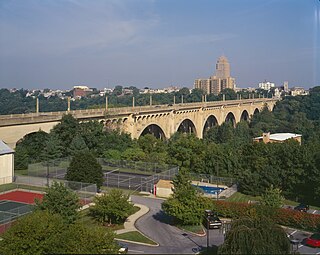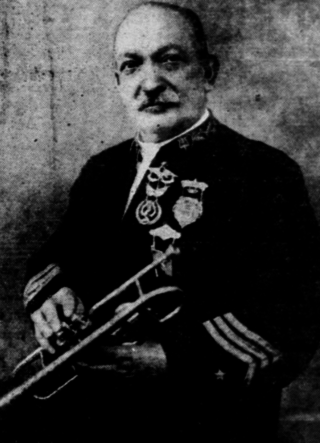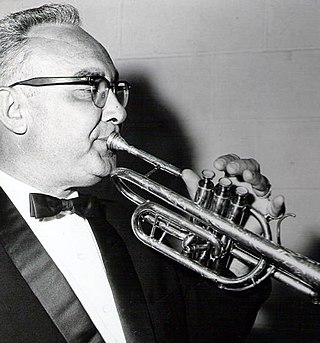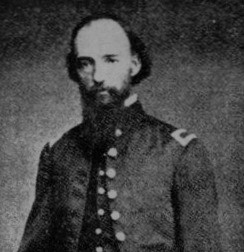
Allentown is a city in Pennsylvania and the county seat of Lehigh County, Pennsylvania, United States. It is the third-most-populous city in Pennsylvania with a population of 125,845 as of the 2020 census and the largest city in the Lehigh Valley metropolitan area, which had a population of 861,899 and was the 68th-most populous metropolitan area in the nation as of 2020.

A concert band, also called a wind band, wind ensemble, wind symphony, wind orchestra, symphonic band, the symphonic winds, or symphonic wind ensemble, is a performing ensemble consisting of members of the woodwind, brass, and percussion families of instruments, and occasionally including the harp, double bass, or bass guitar. On rare occasions, additional, non-traditional instruments may be added to such ensembles such as piano, synthesizer, or electric guitar.

Edwin Franko Goldman was an American composer and conductor. One of the most significant American band composers of the early 20th century, Goldman composed over 150 works, but is best known for his marches. He founded the renowned Goldman Band of New York City and the American Bandmasters Association. Goldman's works are characterized by their pleasant and catchy tunes, as well as their fine trios and solos. He also encouraged audiences to whistle/hum along to his marches. He wrote singing and whistling into the score of "On the Mall".

The American Bandmasters Association (ABA) was formed in 1929 by Edwin Franko Goldman to promote concert band music. Goldman sought to raise esteem for concert bands among musicians and audiences. The reputations of concert bands suffered in comparison to symphony orchestras due to factors including "the concert band’s concert venue, often out-of-doors, the difficulty of conductors to obtain a quality music education, a limited repertoire that with the exception of marches was largely borrowed from the libraries of the orchestra, and a lack of camaraderie among the leading bandmasters/conductors of the period."
"Chimes of Liberty" is a military march by Edwin Franko Goldman (1878–1956). It vies with "On the Mall" as Goldman's greatest hit.

The Albertus L. Meyers Bridge, also known as the Eighth Street Bridge, the South Eighth Street Viaduct, and unsigned as SR 2055, is a reinforced concrete open-spandrel arch bridge located in Allentown, Pennsylvania. The bridge is "one of the earliest surviving examples of monumental, reinforced concrete construction," according to the American Society of Civil Engineers.

Miller Symphony Hall is a 1,100-seat performing arts facility in Allentown, Pennsylvania that hosts the Allentown Symphony Orchestra. The hall was previously known as Central Market (1896), Lyric Theater (1899), and Allentown Symphony Hall (1959). In 2012, it was renamed for the Miller family, longtime owners of the hall and of The Morning Call newspaper.

The Great Allentown Fair is an annual fair and agricultural show that is held at the Allentown Fairgrounds in Allentown, Pennsylvania. It is operated by the Lehigh County Agricultural Society. It is one of the oldest fairs in the United States, and one of the largest in the state of Pennsylvania.
The Bethlehem Municipal Band is an American concert band that has been in existence for 75 years based in Bethlehem, Pennsylvania. The band performs a variety of summer programs in the Bethlehem Rose Garden's Arts in the Park series, as well as selected other venues in the surrounding area.

Allessandro Liberati (1847–1927) was a cornet player and virtuoso. Active mainly in the late 19th century and the early 20th century, he was also known for being a respectable bandleader for his World Renowned Liberati Band, as well as for the composition of Felice, and the Kansas City Star March. He died in 1927.
Frank Bencriscutto, nicknamed "Dr. Ben," was an American conductor and composer of concert band music. Bencriscutto was Director of Bands and Professor of Music at the University of Minnesota for thirty-two years.
"On the Mall" is a famous march composed by American bandmaster Edwin Franko Goldman (1878–1956). It vies with Goldman's "Chimes of Liberty" as his two most popular compositions. "On the Mall" still in 2013, as indicated by Jack Kopstein, remains a featured march and continues to be performed and recorded by bands throughout America and around the world.

Charles Delaware Staigers was an American cornetist. He was born on August 20, 1899, in Muncie, Indiana. In 1914, he was hired to play in Patrick Conway's band. In 1918, he joined John Philip Sousa's band as the assistant to cornet soloist Frank Simon. He stayed with John Philip Sousa through 1920. He played "Taps" at John Philip Sousa's funeral. After leaving Sousa, he became first trumpeter at The Hippodrome and later at The Strand Theatre in New York City. In 1926, he joined the Goldman Band. His first appearance with The Goldman Band in Central Park before a crowd of over 25,000 people drew vociferous applause and bravos. He played with The Goldman Band through 1934, and also for the 1942 season.
The Armed Forces March Competition was a 1954 inter-service contest among the United States Armed Forces organized by the American Society of Composers, Authors and Publishers (ASCAP) and the U.S. Department of Defense and convened as part of that year's observances in commemoration of the birth of John Philip Sousa. Four original marches were selected to receive ASCAP-John Philip Sousa Awards during a February ceremony at The Pentagon.
Albertus L. Meyers was an American music conductor and cornet player from Allentown, Pennsylvania. He was the bandmaster of the Allentown Band for fifty years, from 1926 to 1976. He was also a friend and exponent of John Philip Sousa.

James Francis Burke was an American cornet soloist. He was the principal cornet soloist with the Goldman Band from 1943 to 1974. He was also the principal trumpet with The Baltimore Symphony Orchestra from 1943 to 1949. Mr. Burke, who had the use of only one arm, was considered the greatest virtuoso of his time on the instrument, according to Ainslee Cox, conductor of the Guggenheim Memorial Band.

Thomas P. Coates was a 19th-century American musician who achieved initial prominence in Pennsylvania for his performances on the cornet and French horn. The director of Pomp's Cornet Band in Easton, Pennsylvania, he was commissioned as the first conductor of the regimental band of the 47th Pennsylvania Volunteer Infantry Regiment during the early months of the American Civil War. Post-war, he became a prolific and popular composer of band music, and was subsequently nicknamed "the Father of Band Music in America."
















